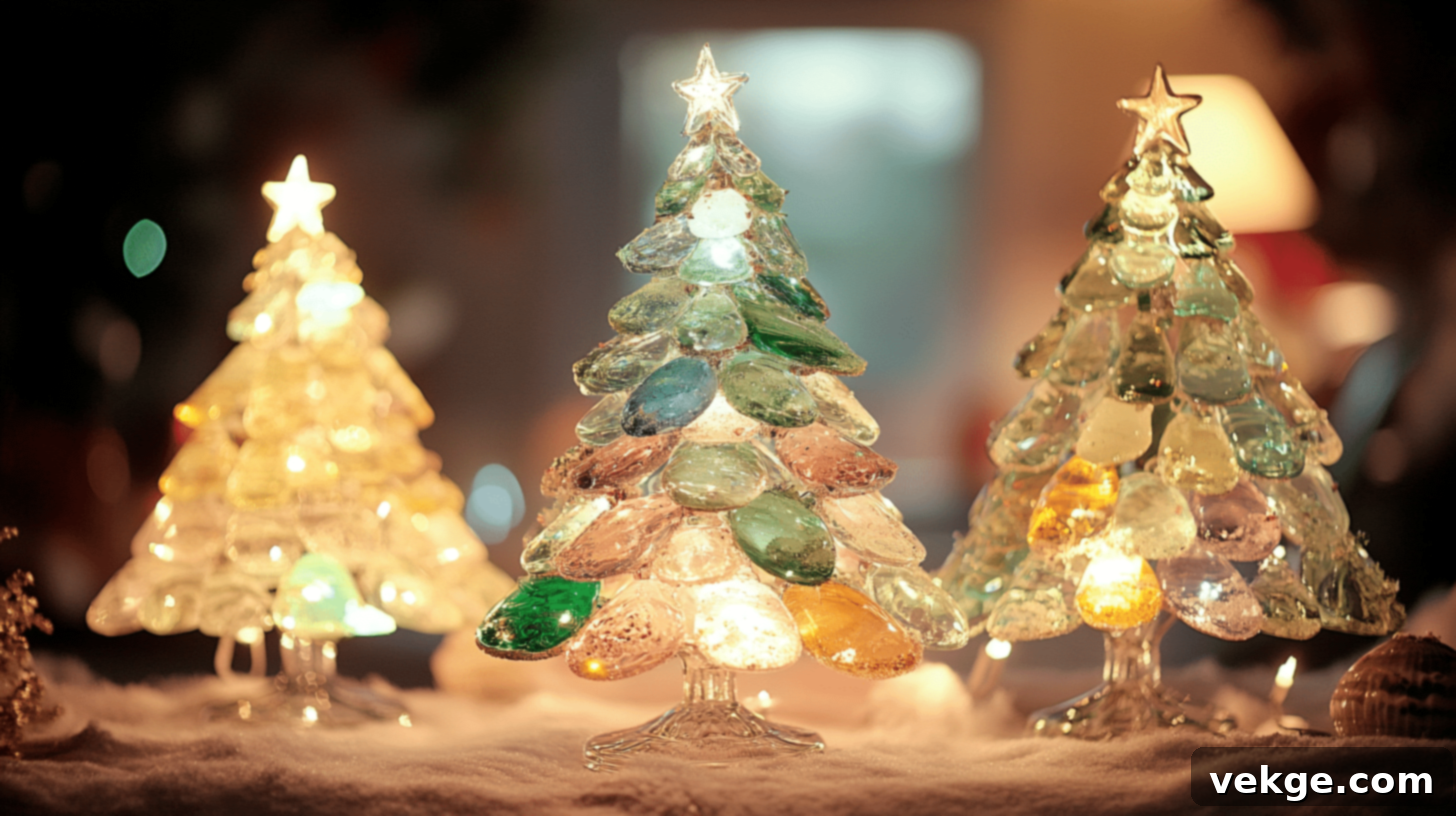Sea Glass Christmas Trees: Your Comprehensive Guide to Coastal Holiday Charm (DIY & Buying)
This holiday season, infuse your home with an enchanting coastal spirit using the timeless beauty of sea glass Christmas trees. These luminous decorations are rapidly gaining popularity, seamlessly blending the festive magic of the holidays with the serene allure of ocean-worn treasures. Moving beyond traditional ornaments, many homeowners are now embracing sea glass to craft truly unique and special festive displays.
Whether you’re a seasoned DIY enthusiast eager to craft your own ocean-inspired masterpiece or you prefer the convenience of purchasing a ready-made tree, this comprehensive guide is designed for you. We’ll delve deep into everything you need to know about sea glass Christmas trees – from understanding the origins of sea glass and mastering the art of building your own tree, to selecting the perfect one to buy. Prepare to transform your holiday decorations into a dazzling spectacle, shimmering with the tranquil beauty of the sea.
Understanding Sea Glass Christmas Trees
What is Sea Glass, and How is it Formed?
Sea glass is a truly remarkable byproduct of nature and human history, found along shorelines worldwide. It begins its journey as ordinary glass – perhaps a discarded bottle, a piece of tableware, or even a ship’s lantern – that finds its way into the ocean. Over decades, sometimes as long as 20 to 50 years, the relentless forces of ocean waves, tides, and abrasive sand work together to transform these sharp, broken shards. This natural tumbling process gradually smooths their edges, creating a rounded, tactile feel, and frosts their surface, giving them a unique matte or “sugared” appearance. This distinctive frosty patina is a hallmark of genuine sea glass, distinguishing it from common beach glass, which is often found in freshwater environments and may not exhibit the same level of frosting due to less saline conditions and different mineral interactions.
The allure of sea glass lies in its individuality; no two pieces are exactly alike. Its diverse range of colors tells a story of its past, reflecting the original glass it once was. Shades of blue and green are the most common, derived from old soda bottles and medicine containers. However, rare colors such as red (from ship lanterns or ruby glass), orange (from older art glass or auto taillights), yellow, lavender, or even black (which appears dark but holds a color when held to light) are highly coveted by collectors and add immense value and character to any creation. The soft, cloudy, ethereal look of sea glass makes it stand out dramatically from manufactured glass, offering a touch of natural artistry.
The Appeal of Sea Glass in Holiday Décor
The integration of sea glass into Christmas decorations has seen a surge in popularity, offering a refreshing and sophisticated alternative to traditional holiday aesthetics. It effortlessly introduces a serene, beach-inspired atmosphere to festive homes, making it particularly appealing for coastal residences or for those longing to bring a piece of the shore inland. The frosty appearance of sea glass naturally harmonizes with winter themes, evoking images of sparkling ice, crisp snow, and tranquil frosty mornings. Its array of muted colors, ranging from deep ocean blues and vibrant aquamarines to soft greens and pristine whites, elegantly mirrors the hues of ocean waters, frosty landscapes, and winter skies.
Sea glass Christmas trees, in particular, are captivating centerpieces. Unlike the often brightly colored and overtly shiny plastic ornaments, they exude a gentle, understated sparkle. This subtle luminosity creates a calm and peaceful ambiance, perfect for those seeking a more tranquil and elegant look for their holiday decor. These trees beautifully marry two beloved concepts – the joyous spirit of Christmas and the calming beauty of the beach. While they are a natural fit for coastal-themed homes, they possess the unique ability to transport the soothing essence of the seashore to any living space, regardless of its geographical location. Furthermore, sea glass trees offer a delightful and imaginative way to diverge from the conventional red and green palette, inviting creativity and personal expression into your holiday styling.
How to Make a Sea Glass Christmas Tree
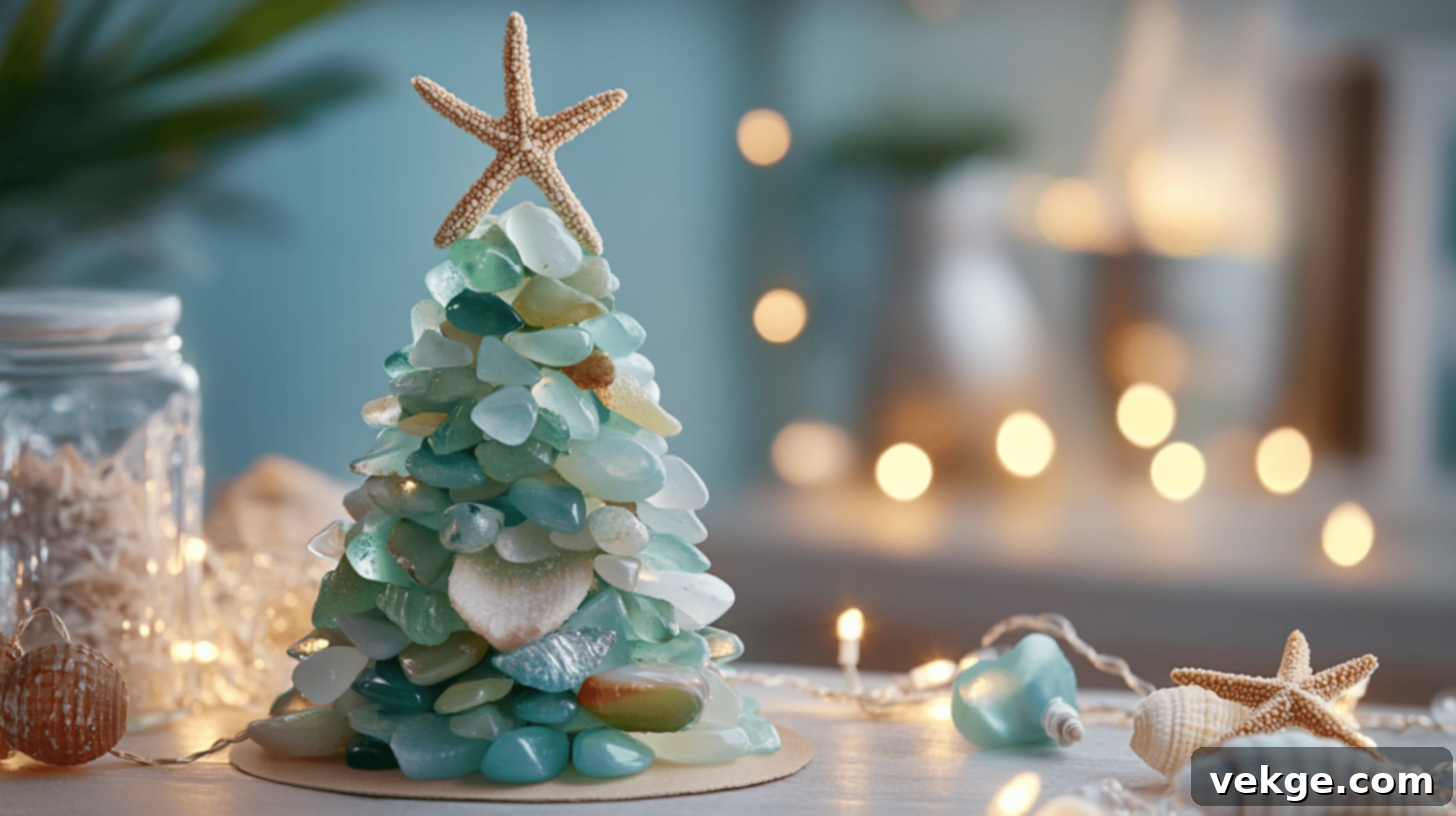
Materials You’ll Need
To embark on the rewarding journey of crafting your very own sea glass Christmas tree, gathering the right materials is your first step. Sourcing quality materials ensures a durable and visually stunning end product.
- Sea Glass Pieces: Acquire a generous assortment of sea glass in various sizes and colors. You can collect these yourself from beaches (ensure it’s legal and ethical in your area) or purchase them from craft stores, online marketplaces, or specialty sea glass suppliers. Prices vary significantly based on color rarity and quantity, typically ranging from $10-$30 per bag for common colors. Consider faux sea glass or tumbled glass for a more budget-friendly or readily available option.
- Cone-Shaped Foam or Cardboard Base: This will form the structure of your tree. Foam cones are generally sturdier and easier to work with, while cardboard cones can be a more eco-friendly choice. These are widely available at craft stores. ($5-$10)
- Strong, Clear-Drying Adhesive: A high-quality glue that dries clear is paramount to ensure your sea glass pieces remain securely attached without visible glue lines. Hot glue guns offer quick adhesion, but a stronger, slow-drying craft glue (like E6000 or a similar industrial-strength adhesive) provides a more permanent bond. ($5-$10)
- Small LED Lights (Optional): If you desire an ethereal glow, micro LED string lights (preferably battery-operated for cordless convenience) can be woven into your design. Warm white lights complement the soft hues of sea glass beautifully. ($5-$15)
- Optional Embellishments: Enhance your tree with a starfish or a unique shell for the topper, or incorporate small shells, pearls, or tiny beads throughout the design for added texture and sparkle. These small touches personalize your creation. ($5-$20)
- Safety Gear: Always prioritize safety. Wear protective gloves to handle sea glass, as even smoothed pieces can have unseen sharp edges. Eye protection is also recommended, especially if you need to gently break larger pieces. ($10-$15)
The total estimated cost for materials typically ranges from $40-$100, depending on the size of your tree, the type of sea glass used (real vs. faux, common vs. rare colors), and additional embellishments. This budget helps readers plan their DIY project effectively.
Step-by-Step DIY Sea Glass Christmas Tree Tutorial
Creating your own sea glass Christmas tree is a deeply satisfying project that yields a unique piece of holiday decor. Follow these steps for the best results:
1. Prepare Your Workspace
- Protect Your Surfaces: Lay down newspaper, a drop cloth, or an old tablecloth to shield your work surface from glue spills and debris.
- Organize Your Sea Glass: Sort your sea glass pieces by size and color. This makes it easier to select appropriate pieces as you work up the tree and helps you maintain a consistent aesthetic or create intentional color gradients. Having them organized saves time and allows for better design planning.
2. Prepare the Base
- Stabilize the Cone: Place your foam or cardboard cone base on a flat, stable surface. A small weighted base underneath can add extra stability if your cone feels light.
- Optional Base Treatment: If you wish, you can paint the cone a complementary color (like white, light blue, or a sandy tone) or wrap it in fabric before attaching the glass. This ensures that any small gaps between the sea glass pieces blend seamlessly with the base rather than exposing the raw cone material. Allow any paint or fabric glue to dry completely before proceeding.
3. Arrange and Attach the Sea Glass
- Begin at the Bottom: Start attaching your sea glass pieces from the widest part of the cone at the bottom, working your way upwards. Use larger, flatter pieces for the base row to create a strong foundation.
- Layering for Full Coverage: Overlap the pieces slightly, much like shingles on a roof, to ensure full coverage and create a dimensional, textured look. This also helps to conceal the base material.
- Glue Application: Apply a small but sufficient amount of your chosen clear-drying glue to the back of each sea glass piece. Press each piece firmly onto the base, holding it for a few seconds to ensure initial adhesion, especially if using a slower-drying glue. Work in small sections to prevent the glue from drying before you can attach the glass.
- Vary Placement: Randomly mix shapes and sizes (within your sorted piles) for a natural, organic appearance, or arrange them in a more structured pattern for a uniform look.
4. Incorporate Lights (If Desired)
- Strategic Weaving: If you’re adding lights, it’s best to weave them into the tree as you go, rather than trying to add them at the very end. After attaching a few rows of sea glass, carefully place sections of the LED string lights, securing them with a tiny dot of glue or by tucking them beneath the glass pieces.
- Conceal Wires: Ensure the wires are as hidden as possible by running them along the cone and beneath the sea glass. Make sure the battery pack (if applicable) is easily accessible at the bottom or back of the tree for switching on/off and battery changes.
5. Add Finishing Touches
- The Topper: Once all the sea glass is attached and the glue has dried, crown your tree with a special topper. A beautiful starfish, a delicate large shell, or even a cluster of small pearls makes an ideal focal point. Secure it firmly with glue.
- Embellishments: Step back and assess your tree. If desired, glue on small accent shells, tiny polished beads, or other miniature beach-found treasures in sparse areas or to add extra sparkle.
Remember to exercise patience and precision throughout this project. While it is incredibly fun and creatively rewarding, allowing adequate drying time for glue and meticulously placing each piece will ensure your sea glass Christmas tree is not only beautiful but also durable.
For a detailed visual guide, consider watching the comprehensive video tutorial by The Salty Spirit on YouTube.
Do’s and Don’ts When Creating a Sea Glass Christmas Tree
To ensure your sea glass Christmas tree project is successful, beautiful, and safe, keep these practical tips in mind:
Do’s:
- Do Handle Sea Glass with Care: Even though the ocean smooths the edges, some pieces can still have subtle sharp points or fragile areas. Wearing gloves is always a wise precaution to protect your hands.
- Do Take Your Time: This isn’t a race. Rushing through the process can lead to uneven placement, visible glue, or poorly attached pieces that may detach over time. Patience is key to achieving a polished, professional look.
- Do Pick a Color Scheme: Deciding on a specific color palette (e.g., all blues, mixed greens and whites, or a vibrant pastel mix) before you start will give your tree a cohesive, intentional, and aesthetically pleasing appearance.
- Do Use a Strong, Clear-Drying Glue: Investing in a high-quality adhesive that dries transparent is crucial. This not only ensures a secure, long-lasting bond for your glass pieces but also prevents unsightly yellowing or cloudy residue.
- Do Work in a Well-Lit Area: Good lighting is essential. It helps you accurately assess color placement, spot any gaps, and ensure each piece is positioned and glued perfectly, leading to a more refined final product.
Don’ts:
- Don’t Feel Limited to Real Sea Glass: If authentic sea glass is too expensive, hard to find, or you need a lot, don’t hesitate to use high-quality faux sea glass or tumbled glass. They offer a very similar aesthetic and are much more accessible.
- Don’t Forget to Account for Lights (If Using): If you plan to incorporate LED lights, make sure to integrate them as you build the layers of glass, leaving space for wires and battery packs. Trying to add them afterward can be difficult and may damage your tree.
- Don’t Worry About Perfection: Embrace the organic nature of sea glass. Each tree will have its own unique character, much like every piece of sea glass. Imperfections often add to its charm and handmade appeal.
- Don’t Apply Too Much Glue: A little glue often goes a long way. Excessive glue can ooze out, create visible marks, and detract from the clean, delicate look of the sea glass. Apply just enough to create a firm bond.
- Don’t Feel Limited to Just Green and Blue: While classic, don’t shy away from incorporating white, brown, or even rare colors like red, orange, or yellow sea glass. Mixing in these colors can add unexpected interest and depth to your tree.
Expert Tips and Tricks To Consider
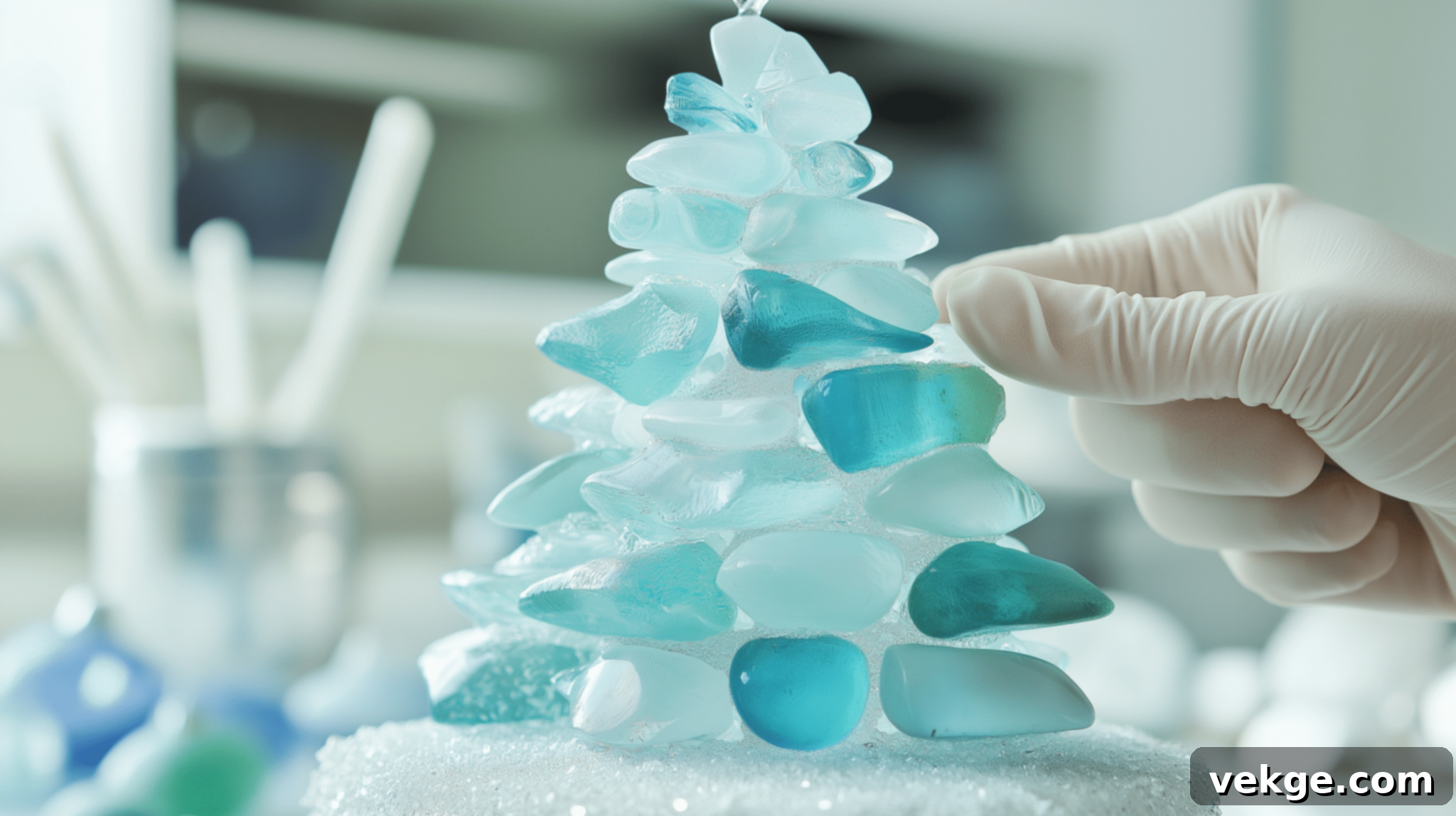
Beyond the basic steps, these expert tips will elevate your sea glass Christmas tree from a simple craft project to a treasured piece of holiday art:
- Safety First: Prioritize Protection: Always wear robust gloves when handling sea glass, as even naturally smoothed pieces can sometimes retain tiny, sharp edges. For added protection, especially if you’re gently manipulating or breaking larger pieces, safety glasses are a highly recommended precaution. Your safety should always be paramount.
- Mastering Color Coordination: Before you start gluing, lay out your sea glass and meticulously plan a specific color theme. Whether you opt for a serene gradient of all blue shades, a refreshing blend of blues and greens, or a vibrant mix of pastels, a well-thought-out color scheme creates a cohesive, professional, and visually stunning appearance that looks intentionally designed.
- Embrace Personalization: Make your sea glass tree truly one-of-a-kind by incorporating meaningful personal items. Consider embedding a small, treasured seashell collected from a memorable family beach trip, a tiny piece of driftwood, or a miniature ornament that holds special significance. These bespoke touches infuse your tree with personal history and allow it to tell a unique story.
- Exploring Alternative Materials: If sourcing enough genuine sea glass proves challenging or expensive, don’t be discouraged. Craft stores and online suppliers offer excellent quality faux sea glass, specifically designed to mimic the frosted, tumbled look of authentic pieces. Tumbled glass, often made from recycled glass, also provides a similar aesthetic and feel, offering an accessible and sustainable alternative.
- Understanding Size Dynamics: To achieve a natural and balanced Christmas tree silhouette, strategically place larger, heavier pieces of sea glass around the base of the cone. Gradually transition to smaller and finer pieces as you ascend towards the apex. This creates a visually harmonious tapering effect, enhancing the overall realism and elegance of your creation.
- Optimizing Lighting Tricks: For an inviting and warm glow, opt for micro LED string lights with a “warm white” tone. These lights emit a soft, comforting luminescence that beautifully complements the gentle, frosted appearance of sea glass. As you attach the glass pieces, meticulously weave and hide the fine wires to ensure that only the enchanting sparkle of the lights is visible, not the mechanics.
- Ensuring a Secure Base: Stability is key for a lasting display. To prevent your finished tree from wobbling or tipping, consider attaching your cone base to a wider, flat, and sturdy foundation. A beautifully weathered piece of driftwood, a large, flat decorative shell, a small wooden plaque, or a ceramic tile can serve as an excellent, theme-enhancing base, providing both stability and aesthetic appeal.
Implementing these expert tips will undoubtedly help you craft a stunning sea glass Christmas tree that you’ll be immensely proud to display and cherish for many holiday seasons to come.
Factors to Consider When Buying a Readymade Seaglass Tree
For those who prefer to purchase a ready-made sea glass Christmas tree, there are several important factors to consider to ensure you invest in a quality piece that perfectly suits your home and style:
- Quality and Authenticity of Sea Glass: Examine the glass closely. Genuine sea glass possesses a distinct frosted, pitted, and smooth texture due to years of natural tumbling. If the glass appears overly shiny, perfectly uniform, or has sharp edges, it might be manufactured or “craft” glass. While high-quality faux sea glass can still create a beautiful tree, be aware of what you are paying for and if it aligns with the price.
- Size and Dimensions: Before purchasing, precisely measure the space where you intend to display your tree. Sea glass trees are available in a wide array of sizes, from charming miniature tabletop versions ideal for a side table or mantel, to impressive floor-standing models that can serve as a primary Christmas tree. Ensure the height and base width are appropriate for your chosen location.
- Integrated Lighting Options: Many ready-made sea glass trees come equipped with pre-installed LED lights. If you desire a radiant, glowing effect, look for trees with well-integrated, warm white lights and a convenient power source (battery-operated or plug-in). If you prefer a more natural, unlit look or wish to add your own external lighting, select a tree without built-in illumination.
- Price Range and Value: Establish a realistic budget before you begin shopping. The price of sea glass Christmas trees can vary significantly based on the size, the quantity and rarity of the glass used, the complexity of the design, and the craftsmanship. A higher price often correlates with authentic sea glass and superior construction, but it’s important to weigh cost against perceived value and quality.
- Cohesive Color Scheme: Consider your existing holiday decor and home aesthetic. Some trees adhere strictly to a calming palette of ocean blues and greens, while others incorporate crisp whites, warm browns, or even rare, vibrant hues like red, yellow, or lavender. Choose a color scheme that complements your personal style and overall festive theme.
- Overall Stability and Construction: A well-made tree should feel solid and stand firmly without any wobbling. Inspect the base to ensure it is wide and robust enough to support the weight of the glass and prevent accidental tipping. Good craftsmanship means secure attachment of all glass pieces.
- Handmade vs. Mass-Produced: Handmade trees, often crafted by artisans, typically offer unique character, intricate detailing, and the charm of an individual creation. They are usually more expensive due to the labor and artistry involved. Mass-produced trees can still be beautiful and more consistently priced, offering a wider range of designs at a potentially more affordable cost.
- Customer Reviews and Seller Reputation: If you are purchasing online, always take the time to read customer reviews and ratings. These can provide invaluable insights into the tree’s actual quality, appearance in real homes, durability, and the seller’s reliability and customer service. Look for consistent positive feedback.
Ultimately, the perfect sea glass Christmas tree is one that resonates with your personal taste, beautifully enhances your home’s holiday atmosphere, and fits comfortably within your budget. Take your time, explore your options, and find that truly special piece that speaks to you.
Seaglass Christmas Tree Design Ideas and Examples
Sea glass Christmas trees offer a versatile canvas for creativity, allowing for a myriad of design possibilities. Here are some inspiring examples to spark your imagination:
1. Coastal Aqua and Teal
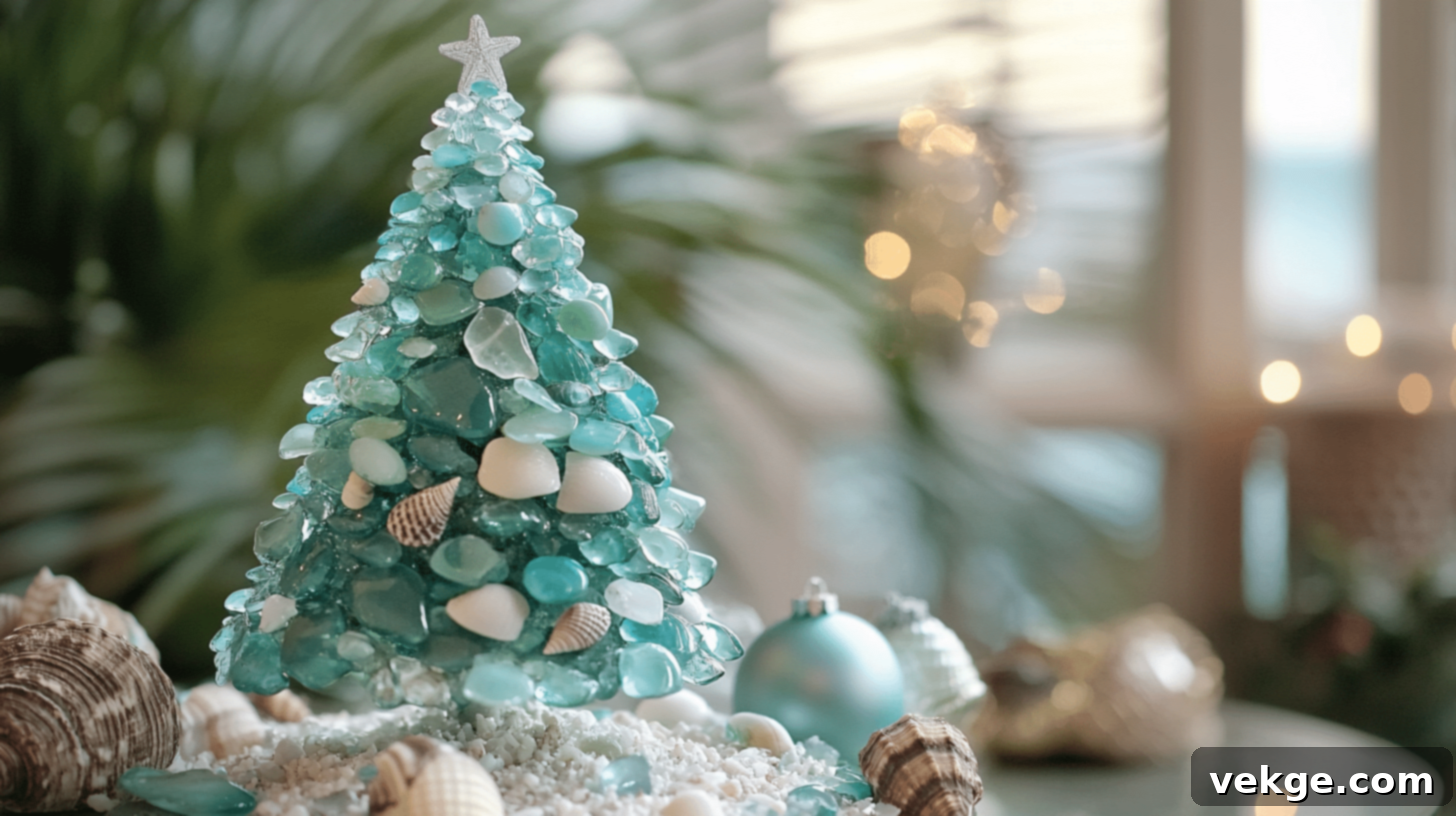
This classic design celebrates the quintessential colors of the ocean. Featuring a beautiful blend of light aqua, deeper teal, and hints of pale blue sea glass, this tree evokes the serene feeling of tropical waters. It pairs beautifully with white, silver, or natural wood accents, perfect for a crisp, clean coastal aesthetic. Add tiny silver shell ornaments or white star lights to enhance its cool, calming vibe.
2. Multi-Colored Pastels
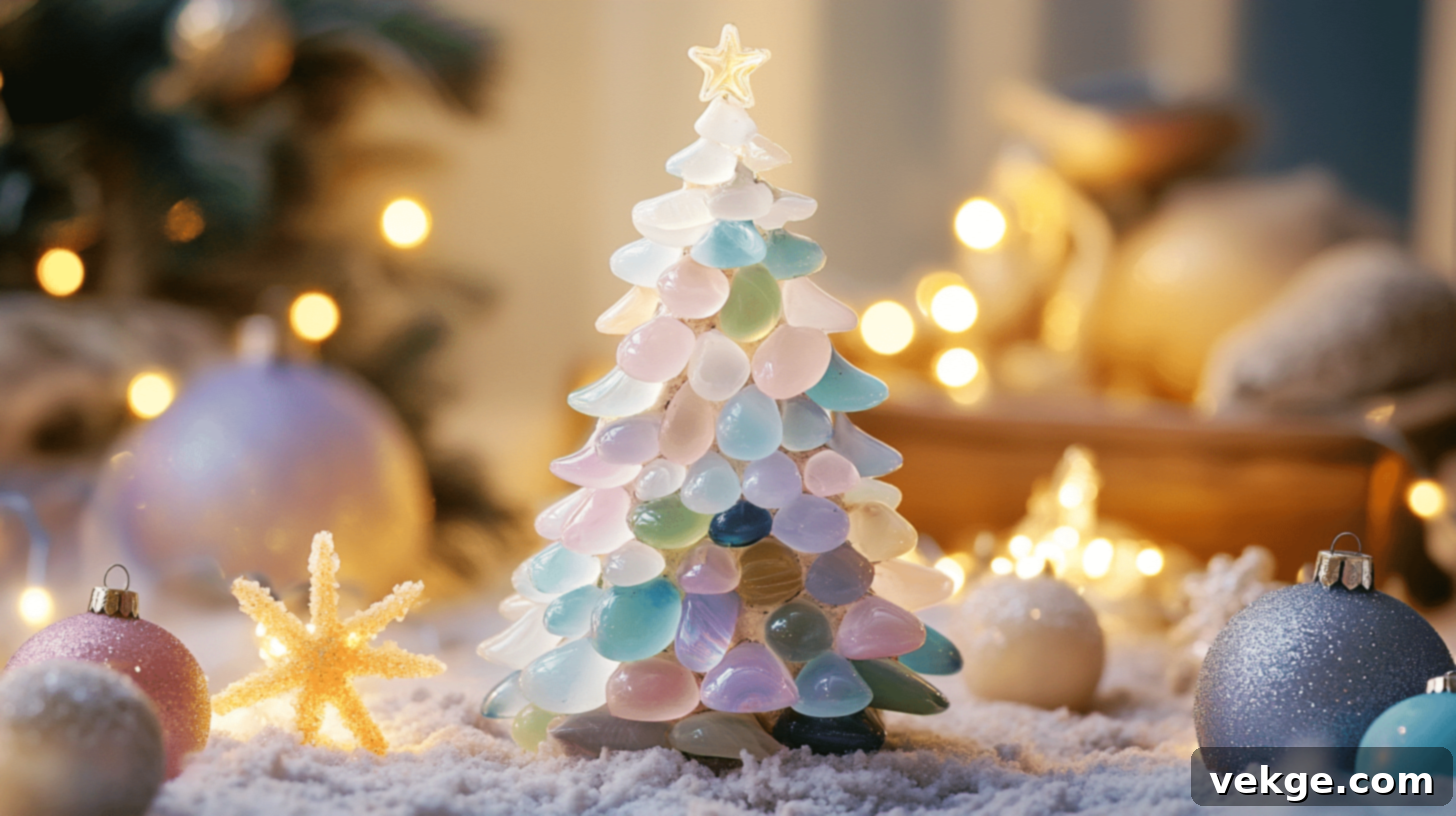
For a whimsical and playful approach, a multi-colored pastel sea glass tree brings a delightful burst of soft hues. Incorporating light pinks, lavenders, pale yellows, and soft greens alongside traditional blues, this design creates a joyful and vibrant centerpiece. It’s an excellent choice for homes with a bohemian, eclectic, or shabby chic decor style, adding a touch of unexpected charm to the holiday season.
3. Emerald Green and Gold

Elevate your holiday decor with the luxurious combination of emerald green sea glass and subtle gold accents. Deep, rich greens create a sophisticated and regal feel, while carefully placed small gold beads, wire, or a gold starfish topper add a touch of opulence. This design is perfect for those seeking a more elegant and refined coastal look, blending natural elements with a touch of glamour.
4. Soft Pink and Rose Gold
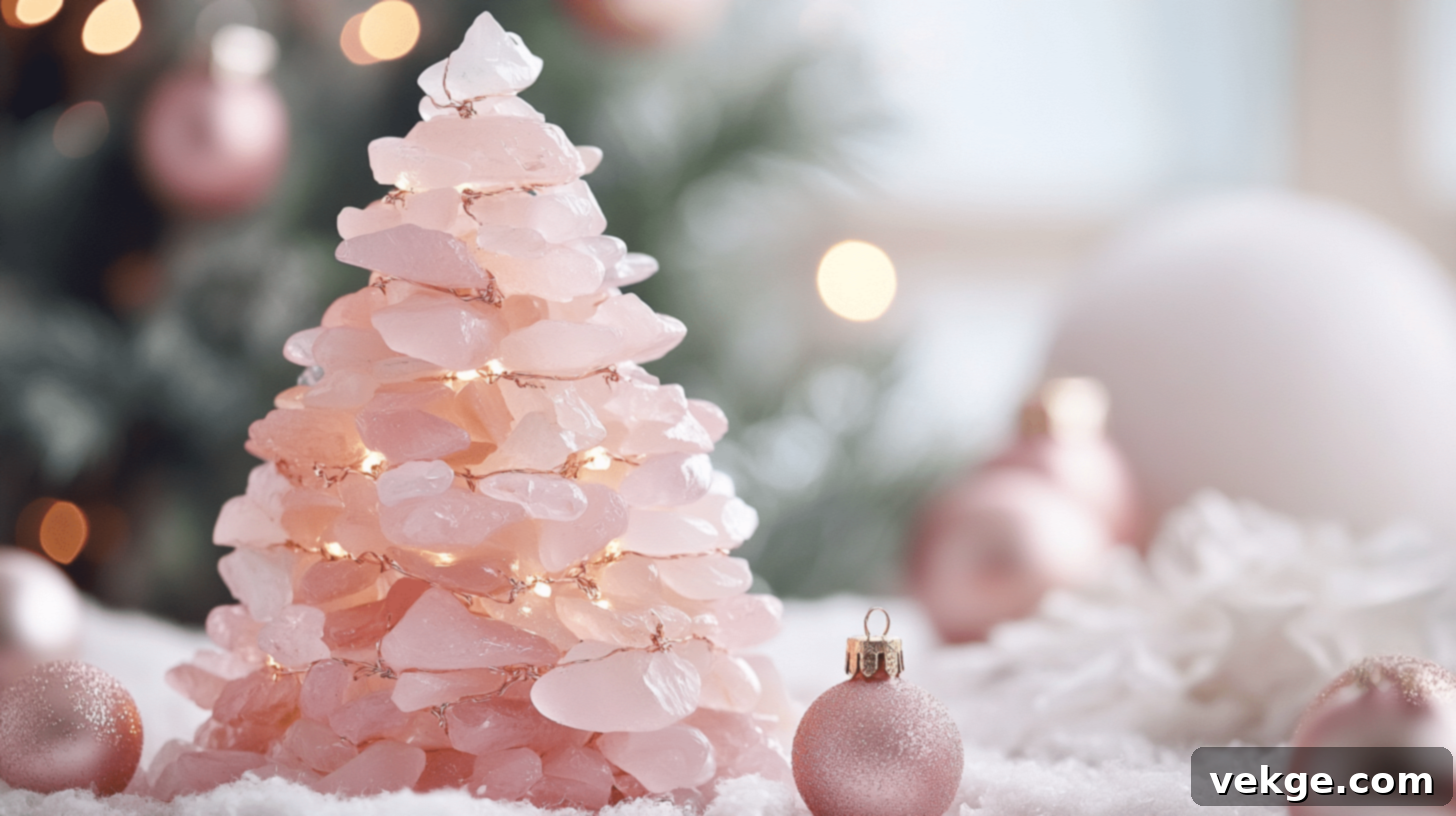
For a romantic and contemporary twist, a sea glass tree adorned with soft pink and shimmering rose gold is absolutely stunning. Utilizing rare pink sea glass or carefully chosen tumbled glass in rosy hues, complemented by rose gold wire, small metallic beads, or a delicate rose gold topper, creates a warm, inviting, and highly fashionable display. This style is particularly popular in modern and feminine interior designs.
5. Turquoise and Coral

Capture the vivid vibrancy of a coral reef with a turquoise and coral-themed sea glass tree. The bright, energetic blues of turquoise sea glass are beautifully contrasted with pops of orange, red, or natural coral pieces (ethically sourced or faux). This bold and lively design is perfect for adding an exotic, vibrant touch to your holiday decorations, bringing the dynamic beauty of the ocean’s depths into your home.
Conclusion
Sea glass Christmas trees represent a delightful and increasingly popular way to introduce a distinctive touch of coastal magic into your holiday decor. Whether you choose the rewarding path of crafting your own unique tree or opt for the convenience and artistry of purchasing a ready-made masterpiece, these shimmering, ocean-inspired trees are guaranteed to add unparalleled sparkle, charm, and a sense of tranquility to your home.
Throughout this comprehensive guide, we’ve explored the fascinating origins and unique appeal of sea glass, provided a detailed step-by-step tutorial on how to construct your own beautiful tree, and offered essential advice on what to consider when investing in a purchased one. We’ve also shared expert tips to enhance your creation and showcased various design inspirations to ignite your creativity. These trees perfectly embody a harmonious blend of beach-found beauty and festive holiday spirit, cultivating a calm, joyful, and utterly unique atmosphere in any setting.
Now, it’s your turn to embrace this trend and bring the enchanting essence of the shore to your door this Christmas. If you embark on the DIY journey, we would absolutely love to witness your artistry! Please share photos of your magnificent sea glass creation online using relevant hashtags to inspire others. Or, if buying is more your style, utilize our guidance to explore reputable sellers for high-quality, stunning trees. Let the captivating allure of sea glass trees inspire and redefine your holiday decorating this season. They offer a truly wonderful, sustainable, and beautiful way to infuse a serene seaside feel into your Christmas celebrations. Enjoy the peaceful, unique glow of your very own coastal Christmas tree!
Frequently Asked Questions (FAQs)
What Is the Difference Between Sea Glass and Beach Glass?
While often used interchangeably, there is a subtle distinction. Sea glass is specifically found on ocean beaches, and its long exposure to saltwater, tides, and sand often results in a deeply frosted, pitted, or “sugared” appearance. Beach glass, conversely, is found along freshwater bodies like lakes and rivers. While also smoothed by water and sand, it typically exhibits less frosting due to different mineral compositions in freshwater, often retaining a slightly glossier finish.
Can I Make a Seaglass Christmas Tree without Real Seaglass?
Absolutely! You can certainly create a stunning Christmas tree using high-quality faux sea glass or tumbled glass. These alternatives are specifically designed to mimic the appearance and texture of genuine sea glass, making them an excellent and often more accessible option. They are available in a wide range of colors and sizes at most craft stores and online retailers, allowing for creative freedom without the scarcity or cost associated with real collected sea glass.
How Do I Care for And Store My Seaglass Christmas Tree?
To ensure your sea glass tree remains beautiful for years to come, handle it with care. Store your tree in a sturdy box, preferably lined with soft padding like bubble wrap, tissue paper, or foam peanuts, to prevent glass pieces from shifting or breaking. Keep it away from extreme heat, direct sunlight (which can sometimes affect glue over very long periods), and excessive humidity. To clean, gently dust your tree with a soft, dry brush or a lint-free cloth. Avoid harsh chemicals or abrasive cleaners, which could damage the glass or the adhesive.
What Types of Glue Are Best for Sea Glass Christmas Trees?
For optimal results, use a strong, clear-drying adhesive. Hot glue guns offer quick setting times, which can be convenient for initial placement, but for a more durable and permanent bond, especially for heavier glass, consider industrial-strength craft glues like E6000, Gorilla Glue Clear, or super glue specifically designed for glass. Always test the glue on a spare piece of glass first to ensure it dries clear and holds well.
Is It Environmentally Friendly to Use Sea Glass?
Yes, using sea glass for crafts like Christmas trees is inherently environmentally friendly! It’s a prime example of upcycling or repurposing. You’re taking discarded human-made waste (glass) that has been naturally tumbled by the ocean and transforming it into a beautiful, functional, and decorative item. This reduces demand for new materials and celebrates natural recycling processes, making it a very sustainable choice for holiday decor.
